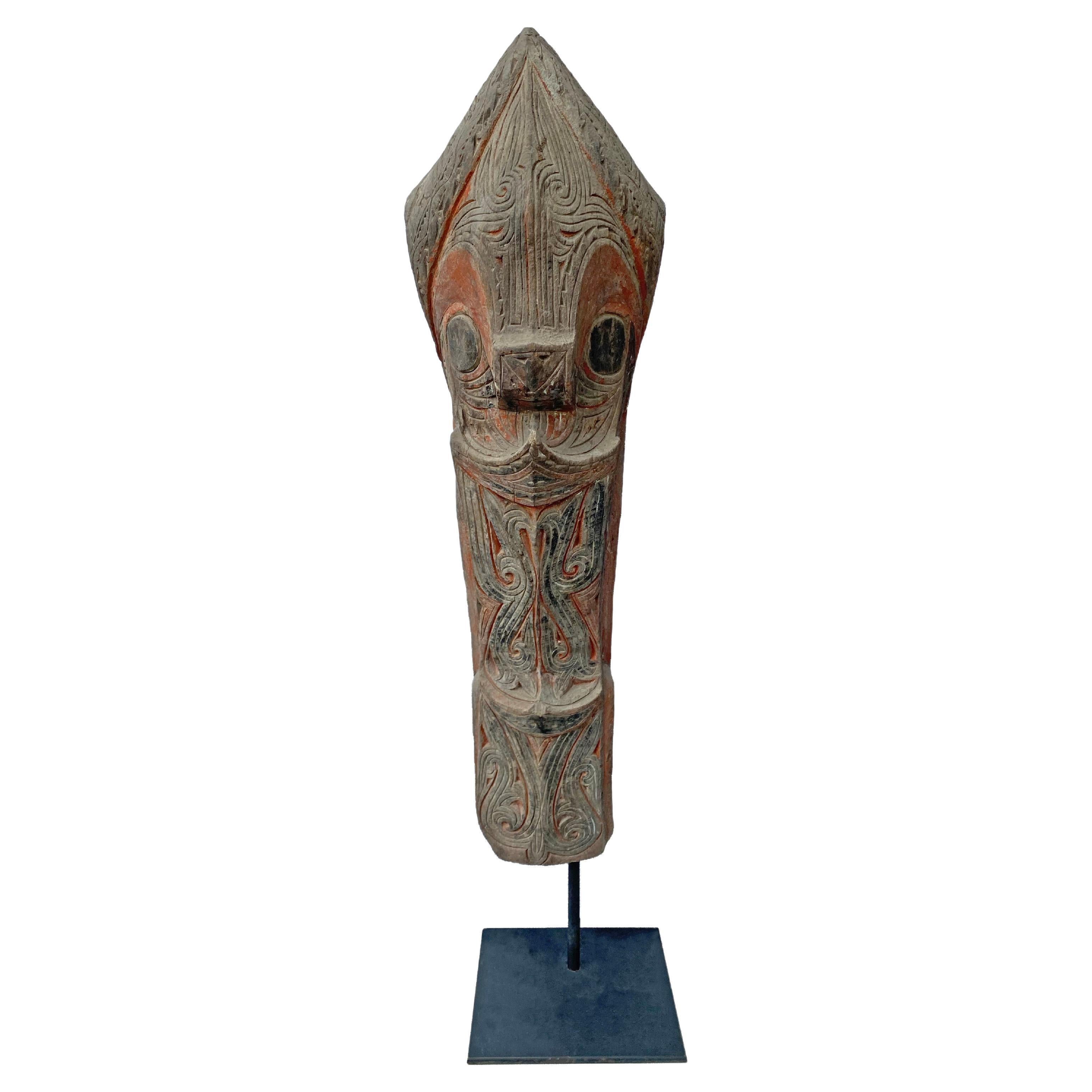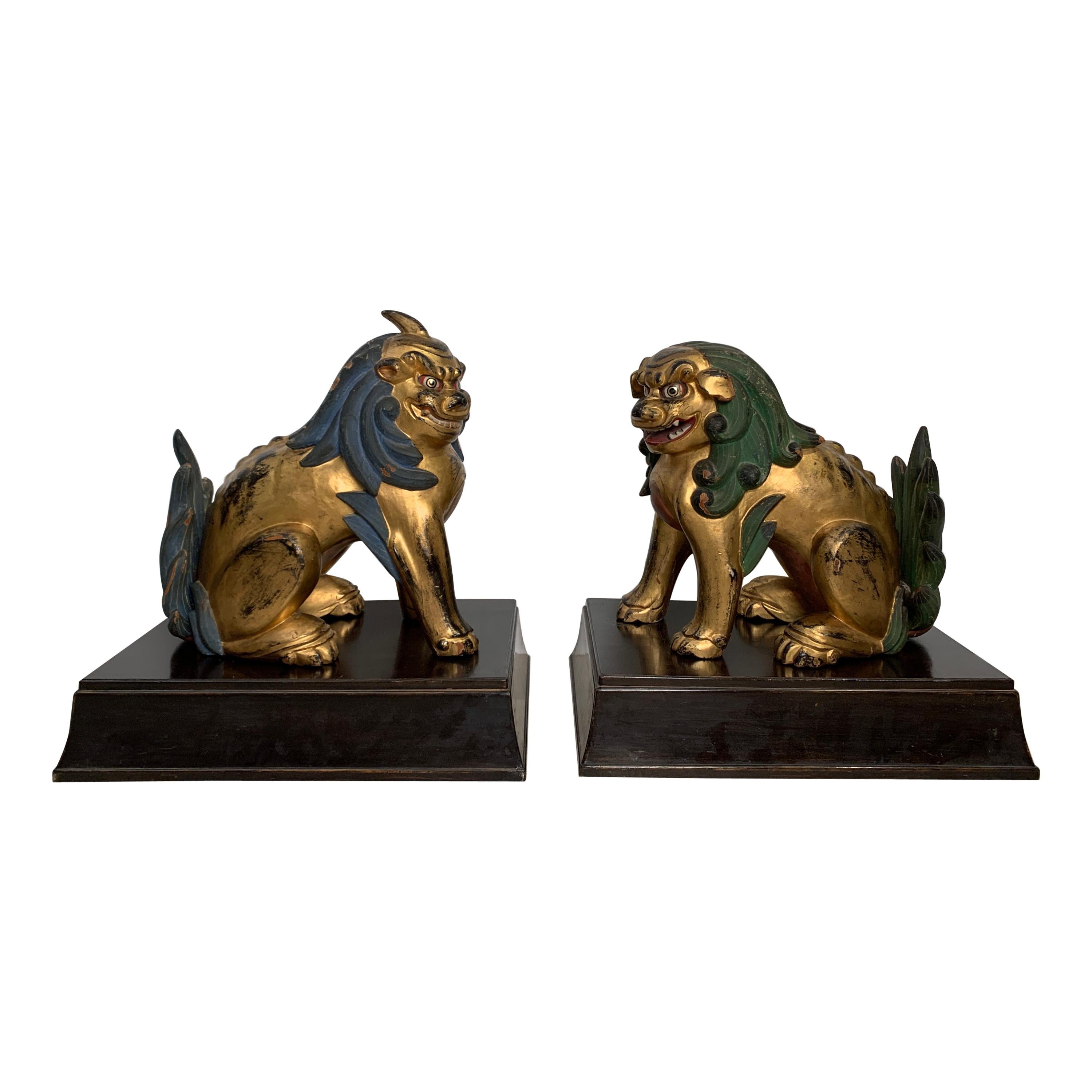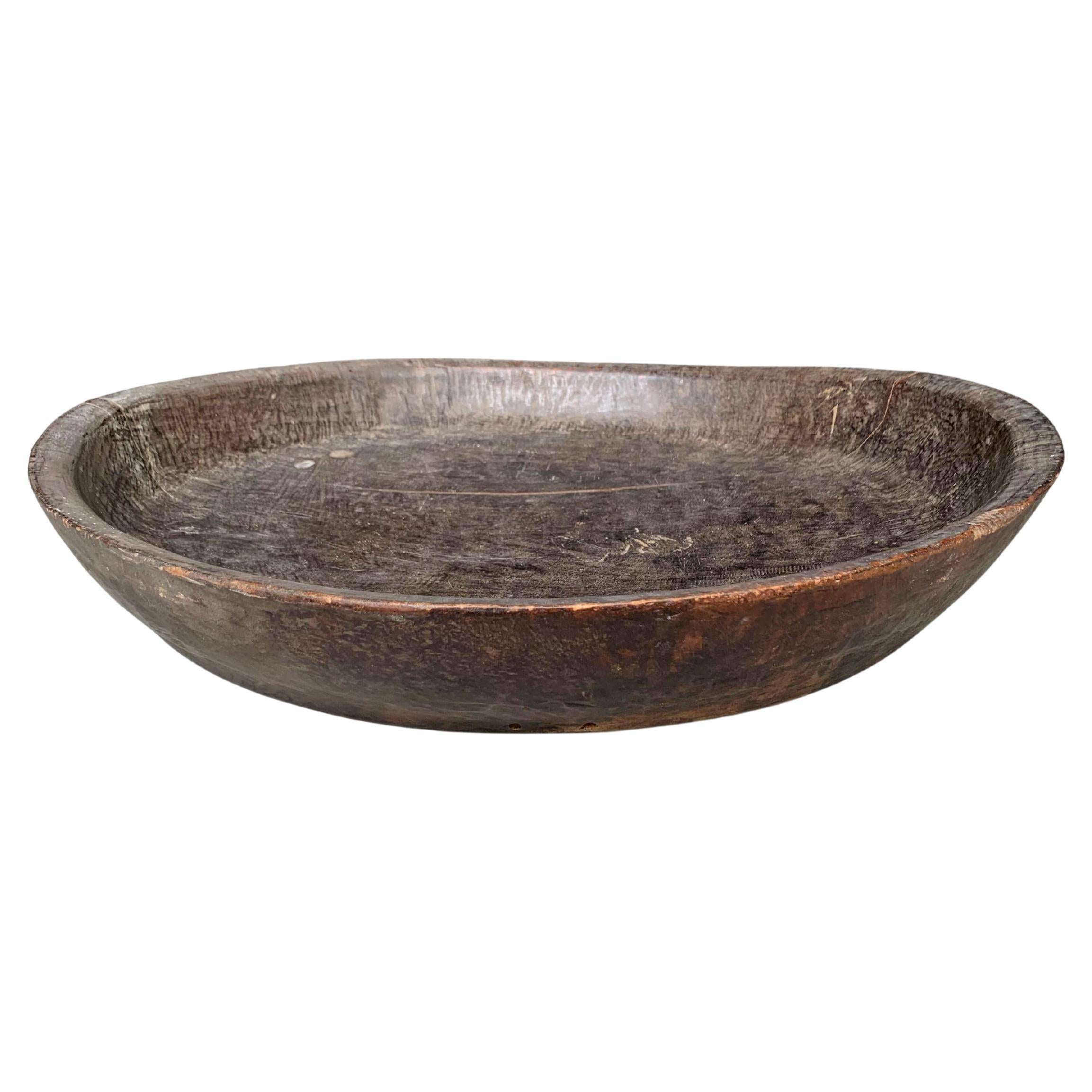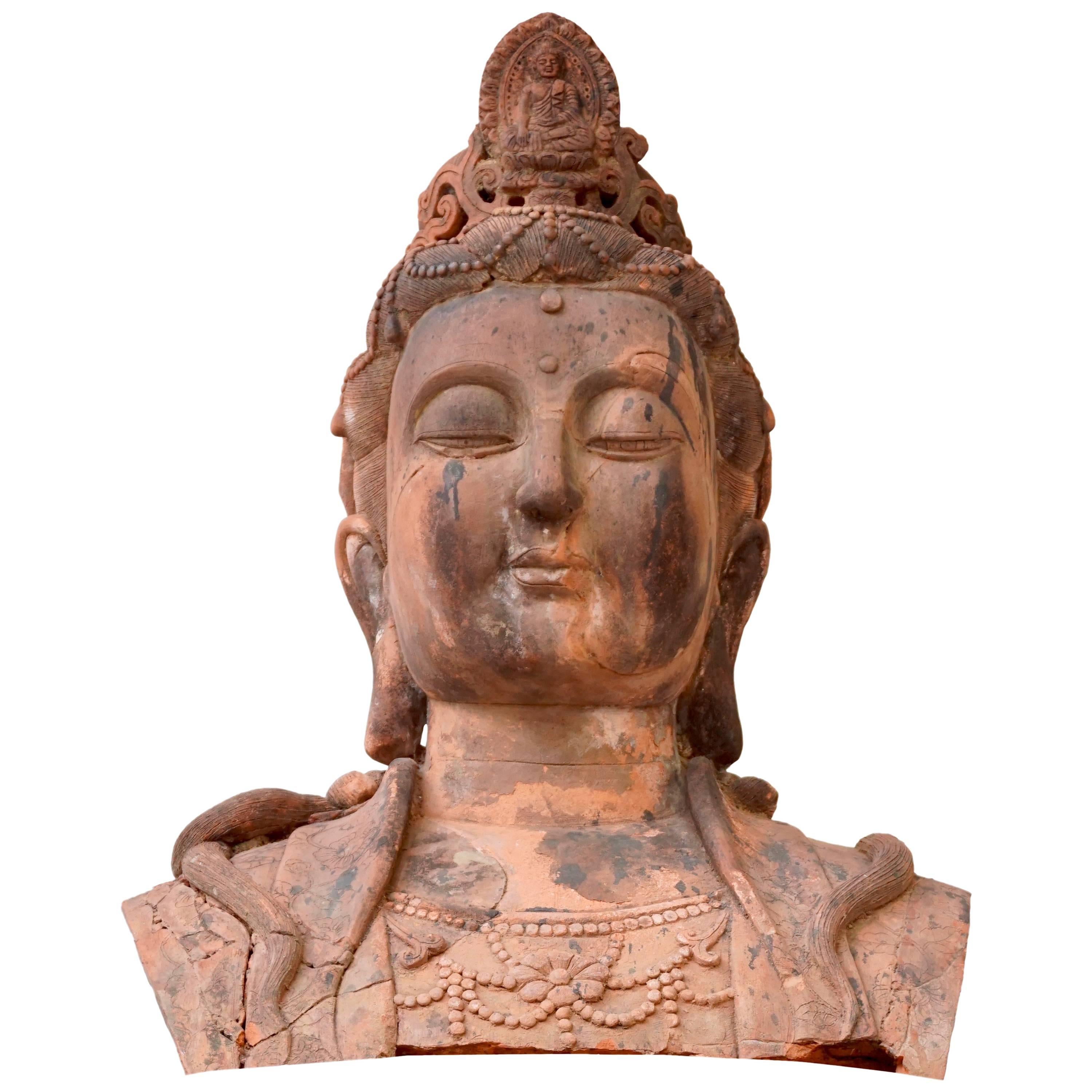Items Similar to Life-Sized Dayak Tribe Female "Hampatong" Guardian, Borneo, Early 20th Century
Want more images or videos?
Request additional images or videos from the seller
1 of 10
Life-Sized Dayak Tribe Female "Hampatong" Guardian, Borneo, Early 20th Century
About the Item
‘Hampatong’ is the term used for ancestors and protective figures made of hard ‘iron wood’, which the Dayak of Borneo would position infront of their houses as guardians. This early 20th century sculpture features light grey age-related patina and displays areas of erosion due to weathering as a result of extended placement outdoors. It features a Merbau wood and metal stand.
Merbau wooden stand - height 65cm x width 45cm x depth 43cm
Statue – Height 135cm x width 40cm x depth 30cm
Total height with stand – 195cm.
- Dimensions:Height: 76.78 in (195 cm)Width: 17.72 in (45 cm)Depth: 16.93 in (43 cm)
- Style:Other (Of the Period)
- Materials and Techniques:
- Place of Origin:
- Period:
- Date of Manufacture:Early 20th Century
- Condition:Wear consistent with age and use. Minor structural damages. Minor fading.
- Seller Location:Jimbaran, ID
- Reference Number:1stDibs: LU5881225438082

About the Seller
5.0
Platinum Seller
These expertly vetted sellers are 1stDibs' most experienced sellers and are rated highest by our customers.
Established in 2004
1stDibs seller since 2021
293 sales on 1stDibs
Typical response time: 6 hours
- ShippingRetrieving quote...Ships From: Jimbaran, Indonesia
- Return PolicyA return for this item may be initiated within 2 days of delivery.
More From This SellerView All
- Singa Guardian Sculpture from the Batak Tribe of Sumatra, Early 20th CenturyLocated in Jimbaran, BaliA Batak Tribe “Singa” from the Indonesian island of Sumatra. This mythical lion figure was used as a protective architectural element on the corner of a traditional Batak house. It f...Category
Early 20th Century Indonesian Other Sculptures and Carvings
MaterialsWood
- Singa Guardian Sculpture from the Batak Tribe of Sumatra, Early 20th CenturyLocated in Jimbaran, BaliA Batak Tribe “Singa” from the Indonesian island of Sumatra. This mythical lion figure was used as a protective architectural element on the corner of a traditional Batak house. It f...Category
Early 20th Century Indonesian Other Sculptures and Carvings
MaterialsWood
- Singa Guardian Sculpture from the Batak Tribe of Sumatra, Early 20th CenturyLocated in Jimbaran, BaliA Batak Tribe “Singa” from the Indonesian island of Sumatra. This mythical lion figure was used as a protective architectural element on the corner of a traditional Batak house. It f...Category
Early 20th Century Indonesian Other Sculptures and Carvings
MaterialsWood
- Dayak Tribe Ironwood Bowl, Early 20th CenturyLocated in Jimbaran, BaliCrafted from ironwood this Dayak tribe ceremonial bowl features a wonderful smooth texture and subtle wood patterns all around. A wonderful decorative bowl...Category
Early 20th Century Indonesian Other Decorative Bowls
MaterialsWood
- Burmese Wooden Teak Nat Statue Spirit Guardians Pair, Early 20th CenturyLocated in Jimbaran, BaliThese statues are adorned wood-carved Burmese Mandalay 'Nat' Spirits from the early 20th century. Nats were worshipped by the Burmese people, depicted as supernatural guardians they ...Category
Early 20th Century Burmese Other Sculptures and Carvings
MaterialsWood, Teak
- Rattan Basket Dayak Tribe Hand-Woven from Kalimantan, Borneo, Mid-20th CenturyLocated in Jimbaran, BaliThis mid-20th century hand-woven basket originates from the Dayak tribe of Borneo crafted with rattan fibres and an iron wood frame. These baskets were used to carry leaves, fruit, g...Category
Mid-20th Century Indonesian Other Decorative Baskets
MaterialsRattan, Wood
You May Also Like
- Pair of Japanese Gilt Wood Komainu, Guardian Lions, Early 20th Century, JapanLocated in Austin, TXA charming and mischievous pair of Japanese carved, gilt and painted komainu, often mistaken for foo dogs or foo lions, Showa Period, 1920's, Japan. The two komainu, or guardian lions, are portrayed seated upon their haunches, heads slightly turned. The two beasts are well carved, with wonderful musculature, flowing manes, and bushy tails. Their faces a mix of ferocious and comical. The eyes of reverse painted glass with gilt highlights. One is a true komainu, (lion-dog), with a horn on its head, and its mouth closed. The other is a shishi, (lion), with its mouth open, and no horn. The komainu sports a mane and tail pigmented blue with gilt highlights. The shishi sports a mane and tail pigmented green with gilt highlights. Both figures richly gilt in gold lacquer. Komainu are protective beings, similar to foo lions or foo dogs...Category
Vintage 1920s Japanese Showa Sculptures and Carvings
MaterialsGlass, Cypress, Wood
- Larger Than Life Terracotta Buddha Bust of Guanyin, Early 20th Century, ChinaLocated in Antwerp, BEA massive larger than life terracotta buddha bust of Guan Yin, China, early 20th century. Broken and restored with wear and tear from enduring exposure to the elements. Size: 75 cm high. Weight: 40 kg. Guanyin, Kwanyin, Guanshiyin or Guanyin Pusa is the Chinese interpretation of the bodhisattva Avalokiteśvara (the goddess of comfort and mercy). In addition, she is seen in Taoism as an immortal. The scripture dedicated to her is Dabeizhou. Guanyin is the goddess of compassion and the sea. She is one of the three saints of the western paradise, along with Mahasthamaprapta and Amitabha Buddha; they are worshiped to save departed loved ones from hell and grant them entrance to the western paradise. Guanyin Chinese name Traditional Chinese 觀音 Simplified Chinese 观音 Transcriptions Full Chinese name Traditional Chinese 觀世音 Simplified Chinese 观世音 Literal meaning "[The One Who] Perceives the Sounds of the World" Transcriptions Second alternative Chinese name Traditional Chinese 觀自在 Simplified Chinese 观自在 Literal meaning "Lord who Gazes down on the World" Transcriptions Burmese name Burmese ကွမ်ယင် IPA [kwàɴ jɪ̀ɴ] Tibetan name Tibetan སྤྱན་རས་གཟིགས Vietnamese name Vietnamese alphabet Quan Âm (Quán Âm) Quán Thế Âm (Quan Thế Âm) Quán Tự Tại Chữ Hán 觀音 觀世音 觀自在 Thai name Thai กวนอิม, พระอวโลกิเตศวรโพธิสัตว์ RTGS Kuan Im, Phra Avalokitesuan Korean name Hangul 관음, 관세음, 관자재 Hanja 觀音, 觀世音, 觀自在 Transcriptions Mongolian name Mongolian script ᠨᠢᠳᠦ ᠪᠡᠷ ᠦᠵᠡᠭᠴᠢ Japanese name Kanji 観音, 観世音, 観自在 Hiragana かんのん, かんぜおん, かんじざい Transcriptions Indonesian name Indonesian Kwan Im, Kwan She Im, Awalokiteswara Filipino name Tagalog Guanyin (ᜄᜓᜀᜈᜌᜒᜈ) Sanskrit name Sanskrit अवलोकितेश्वर (Avalokiteśvara) Khmer name Khmer អវលោកិតេស្វរៈ (Avalokitesvarak), អវលោកេស្វរៈ (Avalokesvarak), លោកេស្វរៈ (Lokesvarak) Hmong name Hmong Kabyeeb, Niam-Txiv Kabyeeb, Dabpog, Niam-Txiv Dabpog Guanyin (traditional Chinese: 觀音; simplified Chinese: 观音; pinyin: Guānyīn) is a Bodhisattva associated with compassion. She is the East Asian representation of Avalokiteśvara (Sanskrit: अवलोकितेश्वर) and has been adopted by other Eastern religions, including Chinese folk religion.[note 1] She was first given the appellation "Goddess of Mercy" or "Mercy Goddess" by Jesuit missionaries in China.[1] Guanyin is short for Guanshiyin, which means "[The One Who] Perceives the Sounds of the World."[2] On the 19th day of the sixth lunar month, Guanyin's attainment of Buddhahood is celebrated.[3] Some Buddhists believe that when one of their adherents departs from this world, they are placed by Guanyin in the heart of a lotus, and then sent to the western pure land of Sukhāvatī.[4] Guanyin is often referred to as the "most widely beloved Buddhist Divinity"[5] with miraculous powers to assist all those who pray to her, as is mentioned in the Pumen chapter of Lotus Sutra and Kāraṇḍavyūha Sūtra. Several large temples in East Asia are dedicated to Guanyin, including Shaolin Monastery, Longxing Temple, Puning Temple, Nanhai Guanyin Temple, Dharma Drum Mountain, Kwan Im Thong Hood Cho Temple, Shitennō-ji, Sensō-ji, Kiyomizu-dera, Sanjūsangen-dō, and many others. Guanyin's abode and bodhimaṇḍa in India is recorded as being on Mount Potalaka. With the localization of the belief in Guanyin, each area adopted their own Potalaka. In Chinese Buddhism, Mount Putuo is considered the bodhimaṇḍa of Guanyin. Naksansa is considered to be the Potalaka of Guanyin in Korea. Japan's Potalaka is located at Fudarakusan-ji. Tibet's Potalaka is the Potala Palace. Vietnam's Potalaka is the Hương Temple. There are several pilgrimage centers for Guanyin in East Asia. Putuoshan is the main pilgrimage site in China. There is a 33 temple Guanyin pilgrimage in Korea which includes Naksansa. In Japan, there are several pilgrimages associated with Guanyin. The oldest one of them is the Saigoku Kannon Pilgrimage, a pilgrimage through 33 temples with Guanyin shrines. Guanyin is beloved by most Buddhist traditions in a nondenominational way and found in most Tibetan temples under the name Chenrézik (Wylie: Spyan ras gzigs). Guanyin is also beloved and worshipped in the temples in Nepal. The Hiranya Varna Mahavihar located in Patan is one example. Guanyin is also found in some influential Theravada temples such as Gangaramaya Temple, Kelaniya and Natha Devale nearby Temple of the Tooth...Category
Early 20th Century Chinese Chinese Export Sculptures and Carvings
MaterialsTerracotta
- Early 20th Century Life Size Carved Female TorsoLocated in Martlesham, GBA fabulous quality Early 20th Century life size carved female torso in the classical style, very well executed in wonderfully figured walnut, the sculpture is in excellent condition ...Category
Vintage 1930s British Figurative Sculptures
MaterialsWalnut
- Monumental Early 20th century Chinese Hardwood Sculpture of a BuffaloLocated in Troy, NYExceptionally large Chinese sculpture of a buffalo in laying down on a simulated carved root-wood base, with five children riding on its back....Category
20th Century Chinese Other Sculptures and Carvings
MaterialsHardwood
- Vintage Chinese Serpentine Sculpture, China, Early 20th CenturyLocated in Roma, ITVintage Chinese serpentine sculpture is a traditional decorative object realized in china in the early 20th century. Serpentine m...Category
Early 20th Century Japanese Figurative Sculptures
MaterialsMarble, Serpentine
- Early 20th Century Sandstone Buddha Head, Northern IndiaLocated in Nantucket, MAA lovely sandstone Buddha head on wooden base, early 1900's, Utttar Pradesh, Northern India. The hand-carved features include the typical snail-s...Category
Early 20th Century Asian Sculptures and Carvings
MaterialsSandstone
Recently Viewed
View AllMore Ways To Browse
Asian Light
Antique Style Houses
Asian Wooden Sculptures
Wood Life Size Sculpture
Carved Wood Female
Antique Asian Statue
Antique Asian Statues
Asian Wooden Carvings
Wood Carvings Figures
Guardian Sculpture
Female Carving
Early Ancestors
Early 20th Century Indonesian
Asian Display Stand
Carved Wood Female Sculpture
Asian Wood Statues
Life Sized Statue
Life Size Statues





